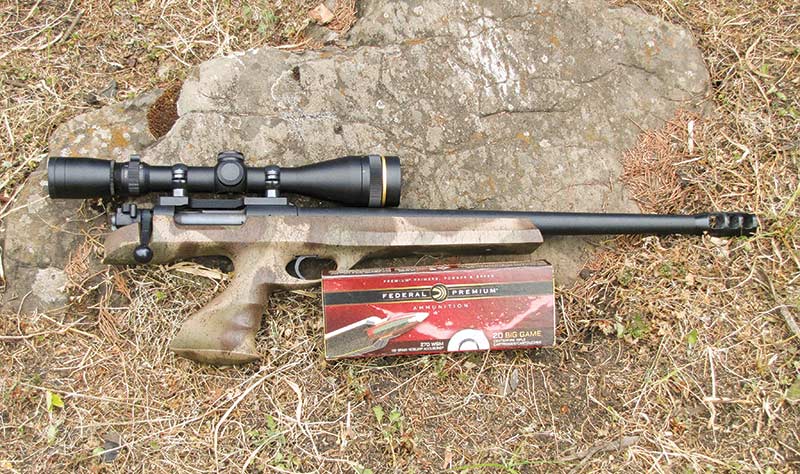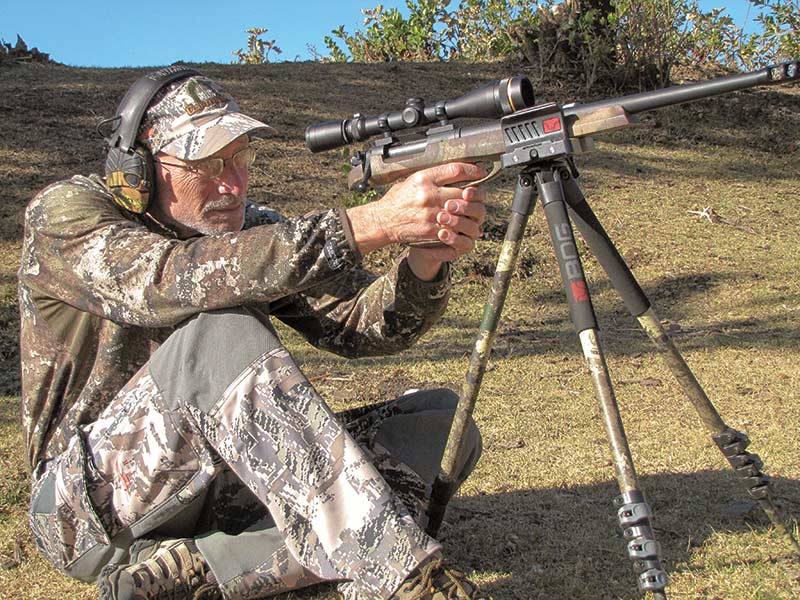After a brief celebration, we begin working our way to the nyala. Now 310 yards is not very far but the terrain was so steep and difficult, it took a good 45 minutes before we made it to the bull. What looks like sprouts and small vegetation from afar is actually 10-foot tall heather. No wonder these animals are difficult to see, as they seldom feed in wide open places. When I first laid my eyes on the nyala, I couldn’t believe what I was seeing. What a magnificent, beautiful animal with massive horns. It was an impressive sight I’ll always cherish.
The Ethiopian adventure was an incredible experience. Observing the culture, friendly people and magnificent wildlife left memories never to be forgotten. The country is home for a variety of wildlife, including lesser kudu — another “bucket list” animal. This spiral-horned antelope calls the Danakil desert home and if good fortune prevails, I just may have to return.
Subscribe To GUNS Magazine
A Tall Mountain — Short Magnum Hunt
The Elusive Ethiopian Nyala Adventure
There comes a time in life when you wake up one morning and the brutal reality of your existence hits home. I’ve wrestled with this sober thought for some time now, realizing there are more days behind me than ahead. It makes a person adjust the thought process. There are a few things in life I would like to experience before the checkered flag halts the race. Hunting mountain nyala is one of those life-long dreams.
My wife and I were headed to Ethiopia as my 65th birthday was approaching. For me, there’s no better way to celebrate this milestone than to embark on a “bucket list” hunt. Ethiopia is an interesting country sandwiched between Sudan and Somalia, resting on the northern border of Kenya. One of the oldest countries in the world, with 110 million inhabitants, Ethiopia is the second most populous in Africa.
We would be hunting in the highland forest for mountain nyala, a large, beautiful spiral-horned antelope. Another magnificent spiral-horned antelope, Menelik’s bushbuck, also thrives in this region and we had procured a permit beforehand to hunt them as well. Our main priority was mountain nyala, the last living ungulate in Africa to be discovered by Westerners. They are only found in high altitude woodlands in a small part of central Ethiopia, where over the years, its habitat has been reduced to only a fragment of what it once enjoyed. Hunters have played a significant role in conserving this species and continue to generate funding creating the incentives needed to protect the mountain nyala and the habitat essential for its continued survival. They are shy, elusive and very challenging to hunt in the thick highland forests making them one of Africa’s top trophies.
The Initial Hunt
The 7-hour drive to camp was most interesting. After dodging goats, cows, donkeys, camels and a few baboons along the way, we arrived in base camp. We were hunting with Dave Rademeyer of Northern Operations Africa. Dave had been hunting this area for many years and had been very successful on mountain nyala.
During the first few days we were hunting close to Dave’s main camp with Menelik’s bushbuck as our target species. These beautiful spiral-horned antelope stay hidden for the most part of the day, only leaving their thickets to feed early in the morning or later in the evening. Several nice males were located during our first few attempts but Dave wanted to take the oldest, most mature male possible so we passed several opportunities. Early one morning I just happened to be glassing a clump of thick brush as a big male stepped out. He had left his bedding area and began feeding in the open.
I quickly got Dave’s attention. One brief look through his Swarovski range-finding binos and two things immediately followed. Dave quietly said this male is old and he was 101 yards away. As fast as possible, I rested the handgun in the tripod and got the Leupold crosshairs steady. Dave whispered, “Take him when you can.” The shot echoed across the canyon while the bushbuck humped up and disappeared. He didn’t go 30 steps so the recovery was quick and painless. Our first Ethiopian trophy was headed for the salt.
I was using an H-S Precision pistol chambered in 270 WSM. This now discontinued handgun is extremely accurate, and with the assistance of Federal’s Premium ammo topped with a 130-grain Nosler AccuBond bullet, the combination is ideally suited for long-range opportunities. While we were lucky to get close to the bushbuck, the mountain nyala is often taken at extended ranges. Dave had forewarned me shots could materialize out to 400 yards and to make certain I knew the point-of-impact from 200 to 400.
Moving Mountains
We moved locations for the mountain nyala, entailing setting up a tent camp and bringing all our food and supplies up another mountain range. The process was interesting as we hired some locals with their donkeys to transport all of our necessary gear up 9,000 feet. The tent camp was comfortable and allowed us to stay right next to mountain nyala habitat.
Our first evening was spent glassing from one mountainside to the adjacent mountain. It was hard to wrap my head around the dense forest and heather at this altitude. Hunting mountain nyala requires a great deal of glassing as the heather is frequently higher than your head and provides innumerable hiding places. Time is spent glassing what few openings exist. The vegetation is so thick, Dave advised me not to look for the entire animal but the tips of their horns or just a part of the animal. We didn’t see any nyala that evening possibly because of the leopard spotted. What a beautiful sight to behold — a leopard in broad daylight!
Early the next morning we got set-up and began glassing the same mountainside. It becomes a bit monotonous but essential to keep searching. You never know when something will appear. About an hour after daylight, one of the scouts spotted a nyala. We quickly changed positions to gain elevation and then Dave got a glimpse of the horns. I could tell by his expression this was a good one!
We tried several different locations in an attempt to see the nyala but he disappeared. Finally we spotted him again — right in the middle of a gauntlet of heather. I could actually see part of his body in the scope but none of us could determine what part. We watched the bull for over an hour but could never risk a shot. The big bull finally bedded down around noon. Dave said, “We’re not leaving here. When he gets back up to feed, he may step in to an opening for a shot.”
So we sat there, waiting and watching. But, as the sun slowly faded, so did our hopes. The curtains closed on the day and we hiked back to camp to endure a “delicious” meal of dehydrated something.
The Final Chase
Long before daylight the following morning — over a strong shot of coffee around the campfire, we speculated what the bull did during the night and would he be anywhere near where we last saw him. Deep down I figured the bull got up in the night and wandered off feeding somewhere. Dave was hopeful we could relocate him if he worked his way farther down the mountainside toward water.
In the predawn darkness, we slowly worked our way back to the location we had been glassing from the day before. By the time we arrived, it was barely light enough to see the adjacent mountainside. Before I could raise my binoculars to scan the area, Dave whispered, “I see him. Get ready!” I couldn’t believe it, so I quickly set up the 270 WSM and settled in. There was very little light on the mountain and it was surprising Dave had spotted the nyala not 200 yards from where we last saw him. Now the trick was for me to find him in the scope. Fortunately there was a white log clearly visible and Dave used this as a reference. The nyala was standing behind a clump of tall vegetation — behind the white log. It was impressive Dave spotted him as you would really have to know what to look for in this dense growth. Through the Leupold scope set on 8x, I couldn’t see the whole animal but his shoulder was exposed.
“He’s 310 yards,” Dave whispered.
Prior to this hunt, I had practiced shooting steel targets on the farm out to 400 yards. Hitting a steel plate from 300 yards was relatively easy with a good rest and the accurate H-S Precision. But I must confess, in low light conditions with the vital area partially exposed on an animal I’ve dreamed about hunting all of my life — it was the longest 310 yards I’ve ever attempted!
Dave whispered, “Don’t shoot unless you’re sure.” Trying to calm myself from the massive amount of adrenaline flowing, as the crosshairs settled I slowly squeezed the trigger. When the shot broke, I could clearly hear the bullet impact since I was wearing stereo muffs. Dave said load again, because the nyala was still standing. The big bull took a couple of steps and fortunately I could still see his shoulder. When the second round struck home, Dave slapped me on the back and said he was down. A monumentally jubilant moment for this country boy!















